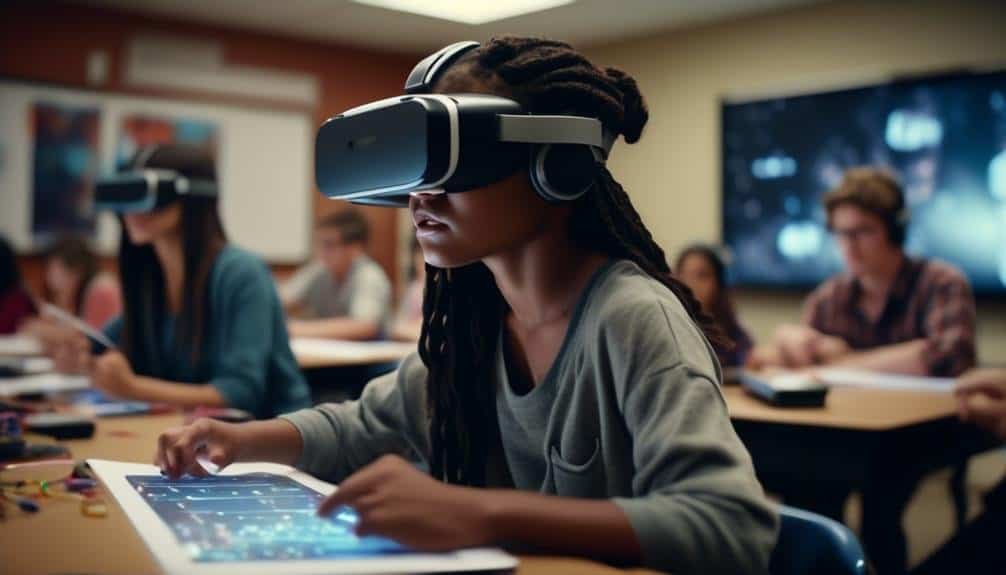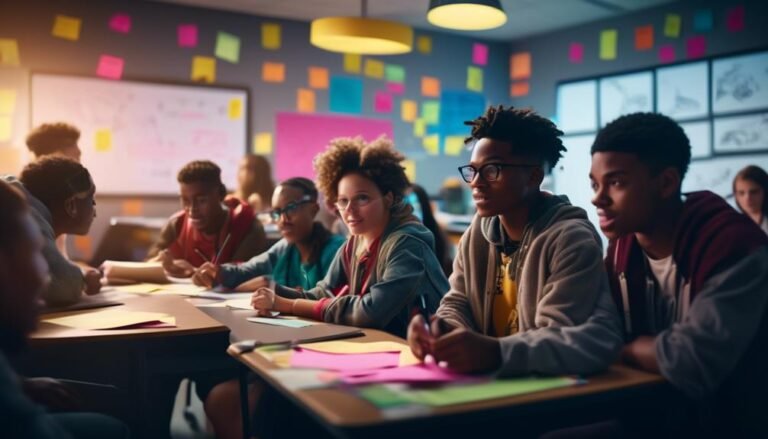Integrating Educational Technology in Teaching
They say that 'knowledge is power,' and in today's digital age, integrating educational technology in your teaching can be a game-changer. But where do you start? How can you effectively leverage technology to enhance student learning?
In this discussion, we will explore the importance of educational technology, the advantages it brings to the classroom, the challenges you may face, and the strategies and resources that can help you seamlessly integrate technology into your teaching practice.
Get ready to embark on a journey that will transform your classroom into an engaging and innovative learning environment, leaving both you and your students excited for what lies ahead.
Key Takeaways
- Educational technology enhances student engagement and facilitates effective learning.
- Integrating technology in teaching creates a more interactive and dynamic learning environment.
- Technology caters to the diverse needs and learning styles of students, promoting personalized learning experiences.
- Educational technology provides access to a wealth of information and resources online, enhancing critical thinking and problem-solving skills.
Importance of Educational Technology
Educational technology plays a crucial role in modern teaching, enhancing student engagement and facilitating effective learning. The importance of technology in education can't be underestimated, as it has a significant impact on student learning. By incorporating technology into the classroom, educators can create a more interactive and dynamic learning environment that caters to the diverse needs and learning styles of students.
One of the key benefits of educational technology is its ability to increase student engagement. With the use of interactive tools, multimedia resources, and online platforms, educators can create stimulating learning experiences that capture students' attention and encourage active participation. Technology also provides opportunities for collaboration and communication, allowing students to engage in meaningful discussions and share ideas with their peers.
Furthermore, educational technology enhances the effectiveness of learning by providing access to a vast array of resources and information. With just a few clicks, students can access online libraries, databases, and educational websites that offer a wealth of knowledge and learning materials. This not only expands their learning opportunities but also promotes independent and self-directed learning.
Advantages of Integrating Technology in Teaching
Integrating technology in teaching offers numerous advantages for educators and students alike. By incorporating educational technology into the classroom, you can enhance the learning experience and improve student outcomes. Here are some key benefits of technology integration:
- Increased student engagement: Technology provides interactive and multimedia resources that can capture students' attention and make learning more enjoyable and relatable.
- Personalized learning: With technology, educators can tailor instruction to meet the individual needs and learning styles of each student, allowing for a more personalized learning experience.
- Access to a wealth of information: The internet and digital resources provide students with access to a vast amount of information, enabling them to explore and research topics in depth.
- Enhancing critical thinking and problem-solving skills: Technology tools and applications promote collaboration, creativity, and critical thinking, helping students develop essential skills for the 21st century.
To effectively integrate technology in teaching, consider the following practical implementation tips:
- Provide professional development: Offer training and support to educators to ensure they have the necessary skills and knowledge to effectively use technology in the classroom.
- Start small: Begin by incorporating one or two technology tools or resources and gradually expand as you become more comfortable and confident.
- Foster a supportive classroom environment: Encourage students to experiment, make mistakes, and learn from them, creating a culture of exploration and growth.
- Regularly assess and evaluate the impact: Continuously monitor the effectiveness of technology integration and make adjustments as needed to optimize student learning outcomes.
Challenges of Incorporating Educational Technology
When incorporating technology into teaching, educators often face various challenges that can impact the implementation and effectiveness of educational technology. Overcoming these obstacles is crucial for successful integration.
One of the main challenges is the lack of technology integration training for teachers. Many educators aren't equipped with the necessary skills and knowledge to effectively use educational technology in their classrooms. Without proper training, teachers may struggle to navigate and utilize the technology tools available to them.
Another challenge is the resistance to change. Some educators may be hesitant to incorporate technology into their teaching practices due to fear or unfamiliarity. It's important to address this resistance by providing support and guidance to help teachers understand the benefits and potential of educational technology. By offering training sessions, workshops, and ongoing support, educators can gradually overcome their resistance and become more comfortable with integrating technology.
Furthermore, the rapid pace of technological advancements poses a challenge for educators. Keeping up with the latest trends and tools can be overwhelming and time-consuming. It's crucial for educators to continuously update their knowledge and skills to ensure effective technology integration.
Effective Strategies for Integrating Technology in the Classroom
Looking to integrate technology in your classroom?
There are many benefits to doing so, such as increased student engagement and personalized learning experiences.
To effectively incorporate technology, consider practical implementation tips such as:
- Starting small with one tool at a time
- Providing proper training and support for both teachers and students
- Regularly evaluating the effectiveness of the technology used.
Benefits of Technology Integration
Using technology in the classroom offers numerous benefits that can enhance teaching and learning experiences for both educators and students. Here are some advantages of technology integration:
- Increased engagement: Technology provides interactive and immersive learning experiences that capture students' attention and make learning more enjoyable.
- Personalized learning: With technology, educators can tailor instruction to meet individual student needs, allowing for differentiated and personalized learning experiences.
- Access to vast resources: Technology enables access to a wealth of information and resources online, expanding the scope of learning beyond the classroom.
- Innovative teaching methods: Integrating technology allows educators to employ innovative teaching methods such as gamification, virtual reality, and simulations, making learning more engaging and effective.
Practical Implementation Tips
To effectively integrate technology in the classroom, consider these practical implementation tips that can enhance teaching and learning experiences for both educators and students.
One of the first tips is to start small and gradually incorporate more technology into your lessons. This allows for a smoother transition and helps you overcome any implementation challenges that may arise.
Another tip is to provide professional development opportunities for educators to learn how to effectively use the technology tools in their teaching. This helps build their confidence and ensures that they're using the technology to its full potential.
Additionally, it's important to have a plan in place for troubleshooting technical issues that may occur during class. This will help minimize disruptions and keep the focus on learning.
Lastly, regularly evaluate the effectiveness of the technology integration by gathering feedback from both educators and students. This will help identify areas for improvement and ensure that the technology is truly enhancing the teaching and learning experiences.
Best Educational Technology Tools and Resources for Teachers
Teachers can enhance their teaching methods and engage students effectively by incorporating the best educational technology tools and resources. With technology integration becoming increasingly important in the classroom, here are four top-notch tools and resources that can revolutionize your teaching and foster interactive learning:
- Google Classroom: This web-based platform allows teachers to create and manage assignments, share resources, and communicate with students in a centralized online space. It promotes collaboration, organization, and seamless integration with other Google apps.
- Kahoot!: This game-based learning platform offers interactive quizzes, discussions, and surveys that can be customized to suit any subject or grade level. It encourages active participation and boosts student engagement through friendly competition.
- Edpuzzle: With Edpuzzle, teachers can transform any video into an interactive learning experience. You can add questions, comments, and voiceovers to videos, ensuring that students stay engaged and grasp key concepts.
- Nearpod: This all-in-one presentation and assessment tool allows teachers to create and deliver interactive lessons, quizzes, and virtual reality experiences. It promotes real-time collaboration and feedback, making learning more immersive and engaging.
Enhancing Student Engagement With Technology
Incorporating educational technology tools and resources not only revolutionizes teaching methods but also enhances student engagement, making learning more interactive and dynamic. By leveraging technology, teachers can tap into students' motivation and promote personalized learning experiences.
One way to enhance student engagement is by using gamification. Gamified learning platforms, such as Kahoot! or Quizizz, can turn mundane quizzes into exciting competitions. Students are motivated to participate actively and strive for higher scores, resulting in increased engagement and retention of knowledge.
Another effective strategy is the use of interactive multimedia. Incorporating videos, animations, and virtual reality experiences can capture students' attention and make complex concepts more accessible. Interactive multimedia also allows students to explore and interact with the content, promoting a deeper understanding of the subject matter.
To further personalize learning, adaptive learning technologies can be employed. These tools analyze students' performance and provide personalized recommendations and resources based on their individual needs. This individualized approach not only keeps students engaged but also allows them to progress at their own pace, fostering a sense of autonomy and ownership over their learning journey.
In summary, leveraging educational technology can significantly enhance student engagement by tapping into their motivation and promoting personalized learning experiences. By incorporating gamification, interactive multimedia, and adaptive learning technologies, teachers can create a dynamic and interactive learning environment that keeps students motivated and actively involved in their own education.
| Strategies for Enhancing Student Engagement |
|---|
| Gamification |
| Interactive Multimedia |
| Adaptive Learning Technologies |
Promoting Collaborative Learning Through Technology
To promote collaborative learning through technology, you can incorporate digital group projects and virtual teamwork activities into your teaching.
These methods allow students to work together, share ideas, and collaborate on tasks, regardless of their physical location.
Digital Group Projects
How can educational technology be utilized to enhance collaborative learning through digital group projects?
Digital group projects provide an opportunity for students to engage in online collaboration and develop essential skills for the 21st century.
Here are some ways in which educational technology can enhance collaborative learning through digital group projects:
- Real-time collaboration: Online tools allow students to collaborate in real-time, enabling them to work together regardless of their physical location.
- Document sharing and editing: Platforms like Google Docs enable students to share and edit documents simultaneously, promoting active participation and shared responsibility.
- Communication tools: Online platforms provide communication channels such as chat and video conferencing, fostering effective communication and collaboration among group members.
- Project management tools: Technology offers project management tools that help students organize tasks, set deadlines, and track progress, ensuring a smooth workflow and accountability.
Virtual Teamwork Activities
Continuing to build on the benefits of digital group projects, virtual teamwork activities leverage educational technology to further promote collaborative learning. These activities enable students to work together remotely, enhancing their virtual collaboration skills and preparing them for the digital age. One effective method of virtual collaboration is through online simulations. These simulations provide a realistic and immersive environment where students can engage in group tasks, problem-solving, and decision-making exercises. They allow students to apply their knowledge in a practical setting, fostering critical thinking and teamwork. By participating in virtual teamwork activities, students can develop important skills such as communication, leadership, and adaptability. Overall, virtual teamwork activities offer a valuable opportunity for students to collaborate and learn in a digital setting.
| Virtual Teamwork Activities |
|---|
| Virtual collaboration |
| Online simulations |
Using Technology to Differentiate Instruction
Using technology in the classroom allows teachers to easily differentiate instruction to meet the diverse needs of their students. With personalized learning and adaptive technology, teachers can provide individualized support and challenge based on each student's unique abilities and learning styles.
Here are some ways technology can help you differentiate instruction:
- Online assessments: Use digital tools to assess students' prior knowledge and understanding of concepts. This allows you to identify areas of strength and weakness and tailor your instruction accordingly.
- Virtual simulations and games: Engage students in interactive virtual experiences that cater to their interests and learning preferences. These simulations and games can provide targeted practice and feedback, helping students make progress at their own pace.
- Digital content and resources: Curate a variety of digital materials that cater to different learning styles and abilities. This allows students to access information in ways that best suit their needs, whether through visuals, videos, or interactive activities.
- Adaptive learning platforms: Utilize adaptive learning software that adjusts the difficulty level and pace of instruction based on students' performance. This ensures that each student receives instruction that's challenging yet achievable, promoting continuous growth.
Assessing and Evaluating Student Learning With Technology
Technology offers effective methods for assessing and evaluating student learning in a way that's personalized and efficient. One important way technology can be used in formative assessment is through the use of online quizzes and interactive activities. These tools allow students to receive immediate feedback on their understanding of the material, enabling them to identify areas where they need further practice or clarification.
Additionally, technology can collect and analyze data on student performance, providing teachers with valuable insights into student progress and areas of difficulty. This data can then be used for instructional decision making, allowing teachers to tailor their instruction to meet the specific needs of their students. For example, if the data shows that a majority of students are struggling with a particular concept, the teacher can adjust their teaching strategies or provide additional resources to address this issue.
Conclusion
In conclusion, integrating educational technology in teaching is essential for modern classrooms. By embracing technology, teachers can enhance student engagement, promote collaborative learning, and differentiate instruction to meet individual student needs.
Despite the challenges, effective strategies, such as utilizing the best educational technology tools and resources, can be employed to overcome obstacles. Assessing and evaluating student learning with technology allows for a more comprehensive understanding of student progress.
Embrace the power of educational technology to transform teaching and empower students for success.







